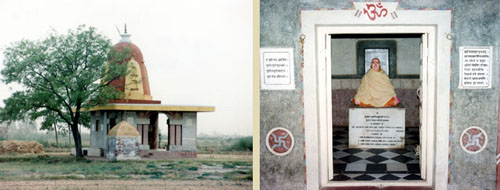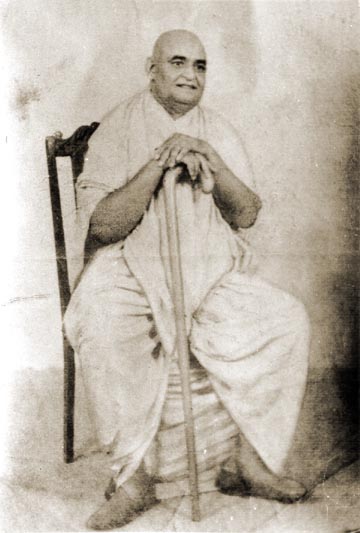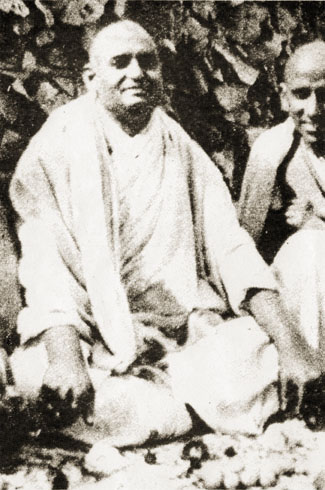SOUL CONNECTIONS HOME | PREVIOUS PAGE | NEXT PAGE
Tapaswiji Maharaj

Above: The Samadhi of Tapaswiji Maharaj in Koshi, between Delhi and Agra (1996).

Above: Tapaswiji’s ashram in Nandi Hills, north of Bangalore. The ashram is built on a rock (left), Tapaswiji’s room on top (middle) and a Shivalinga named Tapasishwara is consecrated in a cave beneath (right) (1996).

Above: Tapaswiji’s ashram in Kakinada is now a school (left). There is a Samadhi shrine in back (middle) and his room is preserved (right) (1996).
 Swamiji often spoke about Tapaswiji with
respect and gratitude. Shivabalayogi arranged for the publication of Tapaswiji’s biography, Maharaj by T. S. Anantha Murthy, and the book is dedicated to Shivabalayogi.
Swamiji often spoke about Tapaswiji with
respect and gratitude. Shivabalayogi arranged for the publication of Tapaswiji’s biography, Maharaj by T. S. Anantha Murthy, and the book is dedicated to Shivabalayogi.
Read about the experience Shivabalayogi gave about Tapaswiji’s powerful tapas in Judging Tapaswiji.
 Shriman Tapaswiji Maharaj, a yogi of considerable
fame, had the spiritual powers to recognize his own soul connection with Shivabalayogi.
Shriman Tapaswiji Maharaj, a yogi of considerable
fame, had the spiritual powers to recognize his own soul connection with Shivabalayogi.
Shivabalayogi was sixteen and in his second year of tapas when Tapaswiji first visited in January of 1951. The young yogi was in deep samadhi so Tapaswiji could not talk with him. Nevertheless Tapaswiji Maharaj immediately realized the high spiritual status of Swamiji.
On one occasion Tapaswiji sat before Swamiji and immersed himself in meditation to discover the yogi’s history. At once he recognized the incarnation of Lord Shiva in the young yogi, so when he emerged from his meditation, Tapaswiji prostrated before Swamiji, and worshipped him with flowers, exhorting his own devotees to do the same. Tapaswiji told his companions that Swamiji was a siddha purusha (a perfected soul) who had reincarnated of his own free will for the spiritual regeneration of mankind. He described Swamiji as the embodiment of the yoga of meditation and told them that in one of his former incarnations Swamiji was Shri Chandra (born 1494), son of Guru Nanak, the first Sikh Guru. Shri Chandra founded the Udasi sect of sannyasins (renunciates, ascetics). In that birth, Tapaswiji Maharaj had been one of Shri Chandra’s disciples.
What the great saint revealed about the boy yogi astounded his companions.
Tapaswji's devotees organized a public meeting in Kakinada in honor of Tapaswiji. There, the venerable saint highly praised the spiritual status of Adivarapupeta Balayogi. Tapaswiji told his audience that Swamiji had been his guru in an earlier incarnation, and was an avatar, a divine incarnation performing tapas to save mankind.
![]()
Tapaswiji was born in 1770 in the royal family of the former state of Patiala in northern India. After a life full of action and adventure, the prince took sannyas — the vows of a renunciate — in his fiftieth year. He entered the Udasi sect of sannyasins and assumed the monastic name of Vishnudas. He practiced rigorous spiritual disciplines for decades under the guidance of various gurus.
Once when on a visit to Parashuram Kund in Assam, Tapaswiji met a mahatma who claimed to know the almost forgotten secret of kaya kalpa, the ancient Vedic technique of rejuvenation. Tapaswiji was then nearing his ninetieth year and was increasingly frail from old age. He submitted to this treatment at the request of this knowledgeable mahatma.
The kaya-kalpa treatment took three months. Tapaswiji passed into a comatose state after the first six days of treatment. Twenty-one days later he came out of the coma and remarkable improvements were already noticeable in his body. By the end of the three-month period, he was astonished to find that he had been restored to the same state of health and youthful vigor he had enjoyed as a young man of thirty. Tapaswiji underwent a second kaya kalpa treatment for a full year at the age of 150, and once again for forty days at age 165.
During his long life, Tapaswiji successfully undertook a number of spiritual austerities including twelve years of silence, the kandeshwari tapas (no sitting or sleeping), and the pancha agni or five-fires tapas (performed under the summer sun surrounded by four blazing fires) for twelve years. His devotees came to call him Tapaswiji Maharaj in recognition of these spiritual accomplishments. He had an ashram near the Nandi Hills just north of Bangalore and another in Kakinada near Adivarapupeta. He entered mahasamadhi — the great or final samadhi through which a yogi drops the physical body — at Jhansi on October 12, 1955, at the age of 185 years.
![]()
Tapaswiji Helps the Balayogi
Kakinada is a town about twenty miles from Adivarapupeta. Tapaswiji was staying in Kakinada to inaugurate a new ashram that had been constructed for him called Vishnu Sevashram. Tapaswiji visited Adivarapupeta several times in January of 1951.
One day, Swamiji’s mother Parvatamma garu informed her son about the frequent visits of Tapaswiji Maharaj and his keen desire to meet him. Swamiji readily agreed to a meeting and the news was conveyed to Tapaswiji Maharaj at Kakinada. Tapaswiji Maharaj came that same day and this time Swamiji was not in samadhi when he arrived.
Tapaswiji Maharaj entered the meditation temple and saw the young yogi sitting on a wooden platform. Swamiji followed the customary habit of greeting elders by doing namaskar with bent head and palms together as in prayer. But when he did namaskar to Tapaswiji, the saint reverently told Swamiji, “You are a mahatma. I am only an ordinary sadhu. You must not do namaskar to me. You must not do namaskar to anybody in the future.” From that day on, Swamiji discontinued the practice of doing namaskar.
Tapaswiji sat facing Swamiji and spoke Hindi. The only language Swamiji knew was Telugu, so they communicated through interpreters. Tapaswiji had recognized that the young yogi’s body was near starvation, so he told Swamiji how he had met a number of yogis in the Himalayas who were engaged in similar tapas. All of these yogis, he said, regularly took some food in limited quantities. He advised Swamiji to take a measured quantity of milk every day otherwise, Tapaswiji told him, it was very likely that his body would perish for want of nourishment within the next fifteen to twenty days. Before he left, Tapaswiji purchased a cow and presented it to Parvatamma so she could have an assured supply of milk for her son.
“At that time, Swamiji was not eating anything. Tapaswiji told him that if Swamiji did not eat anything, then within fifteen days the body will perish. He forced Swamiji to have milk. Tapaswiji ordered Swamiji’s mother to make sure he had milk. That is how Tapaswiji helped Swamiji. He also helped Swamiji in tapas many other ways.”

![]()
Tapaswiji had ashrams in Koshi between Agra and Delhi, and in Nandi Hills north of Bangalore. Even in his travels throughout India, Tapaswiji was in constant communication with Balayogi, who was sitting in tapas in Adivarapupeta village.
In his meditation, Tapaswiji came to know that Balayogi was suffering from a burning sensation. He prepared a healing salve and traveled from Nandi Hills to Adivarapupeta to heal the young yogi. Tapaswiji explained that the affliction had been caused by black magic.
By this time, Balayogi had been sitting motionless for so long that his body had become almost paralyzed from stiffness. The medicines that Tapaswiji had brought helped restore some flexibility.
By this time, a small brick room had been built to protect Balayogi from those who would do him harm. It was Tapaswiji who realized the room was like an oven in the tropical heat. He advised the construction of the gopuram over the room, an open dome structure that helped draw off the heat from the room.
Tapaswiji visited the young yogi in October of 1952 an initiated him into the surya mantra, the mantra of the sun. Shivabalayogi mastered that mantra and, in October of 1954, traveled to the world of the sun. When he addressed the public after completing his 12-year tapas, Shivabalayogi talked about his experience of traveling to the sun.
In many ways did Tapaswiji help Shivabalayogi during his tapas. It was significant that Tapaswiji dropped his own body on October 12, 1955, a few months after Shivabalayogi began doing tapas towards the west, the most difficult direction to master. Balayogi suffered greatly, and the one mahatma who had been helping the young yogi could no longer provide guidance or assistance.


